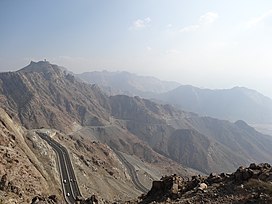Hijaz Mountains
| Hijaz Mountains | |
|---|---|
 | |
| Highest point | |
| Peak | Jabal Werqaan |
| Elevation | 2,393 m (7,851 ft) |
| Coordinates | 23°0′N 41°0′E / 23.000°N 41.000°E |
| Naming | |
| Native name | جِبَال ٱلْحِجَاز Error {{native name checker}}: parameter value is malformed (help) |
| Geography | |
| Country | |
| Region | Hejaz |
The Hijaz Mountains,[1] Arabic: جِـبَـال ٱلْـحِـجَـاز, romanized: Jibāl al-Ḥijāz (Template:IPA-acw), or the "Hejaz Range", is a mountain range located in the Hejazi region of western Saudi Arabia. The range runs north and south along the eastern coast of the Red Sea, and can thus be treated as including the Midian Mountains,[2] and being part of the Sarawat Mountains,[3][4][5] broadly speaking.
Geography
The western coastal escarpment of the Arabian Peninsula is composed of two mountain ranges, the Hijaz Mountain to the north and the Asir Mountains farther south, with a gap between them near the middle of the peninsula's coastline. From an elevation of 2,100 metres (6,900 ft), the range declines towards the vicinity of the gap about 600 metres (2,000 ft).
The mountain wall drops abruptly on the western side toward the Red Sea, leaving the narrow coastal plain of Tihamah. The eastern slopes are not as steep, allowing rare rainfall to help create oases around the springs and wells of the few wadis.[citation needed]
River or wadi
The Hijaz Mountains have been conjectured as the source of the ancient Pishon River, that was described as one of the four rivers associated with the Garden of Eden. This is a component in the research of Juris Zarins that locates the Garden of Eden at the northern tip of the Persian Gulf near Kuwait.
The course of the now dried up river, the modern-day Wadi Al-Rummah and its extension Wadi Al-Batin, was identified by Farouk El-Baz of Boston University and named the 'Kuwait River.' This tracks northeast across the Saudi desert for 600 miles (970 km), following Wadi Al-Batin to the coast of the Persian Gulf. The 'Pishon' or 'Kuwait River,' and the Hejaz region ecology, is estimated to have dried up 2,500–3000 years ago.[6]
Wildlife

The Arabian leopard had been sighted here.[3][4] In ancient times, it was reported that Musa al-Kadhim, a descendant of Muhammad, encountered a lion in the wilderness north of Medina.[7] Hamadryas baboons can be seen near settlements, like those of Al Hada and Al-Shafa near Ta'if.[8]
Mining
This region includes the district of Mahd adh-Dhahab ("Cradle of the Gold"), between Mecca and Medina. It is the only known Arabian source for workable quantities of gold.[citation needed]
Gallery
-
Dhu 'Ain in the area of Al-Bahah
-
A road in the mountains between Al Bahah and Al-Mikhwah
-
Jabal al-Nour ("Mount of Light") near Makkah, associated with Muhammad
-
Mount Uhud in the area of Medinah
-
The Mount of Mercy in Arafat during ḤajjPilgrims supplicating.
See also
- Al Harrah, Saudi Arabia
- Biblical Mount Sinai
- Geology of Saudi Arabia
- List of mountains in Saudi Arabia
References
- ^ "Library of Congress Country Study: Saudi Arabia", The Library of Congress, archived from the original on 2008-09-23
- ^ Scoville, Sheila A. (2006). "3". Gazetteer of Arabia: a geographical and tribal history of the Arabian Peninsula. Vol. 2. Akademische Druck- u. Verlagsanstalt. p. 288. ISBN 0-7614-7571-0.
- ^ a b Judas, J.; Paillat, P.; Khoja, A.; Boug, A. (2006). "Status of the Arabian leopard in Saudi Arabia" (PDF). Cat News (Special Issue 1): 11–19.
- ^ a b Spalton, J. A.; Al-Hikmani, H. M. (2006). "The Leopard in the Arabian Peninsula – Distribution and Subspecies Status" (PDF). Cat News (Special Issue 1): 4–8.
{{cite journal}}: Unknown parameter|last-author-amp=ignored (|name-list-style=suggested) (help) - ^ Nasr, Seyyed Hossein (2013). "1: The Holiest Cities of Islam". Mecca the Blessed, Medina the Radiant: The Holiest Cities of Islam. Tuttle Publishing. ISBN 1-4629-1365-2.
- ^ C.A. Salabach at Focus Magazine Archived 2012-06-25 at the Wayback Machine
- ^ "The Infallibles Taken from Kitab al Irshad By Sheikh al Mufid". Al-Islam.org. Retrieved 2008-11-20.
- ^ Teller, Matthew (1 November 2012). "The Happy Ones". Saudi Aramco World. Retrieved 10 December 2018.













